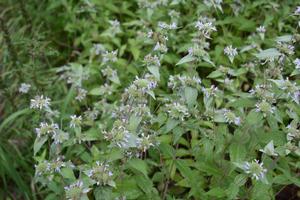Printed at http://www.newmoonnursery.com/index.cfm/
Pycnanthemum incanum
Hoary mountain mint
Native to North America
FIRST IMPRESSIONS: Pycnanthemum incanum is an aromatic perennial wildflower. This mint relative bears oval toothed leaves on strong square stems. In summer, plants are topped by dense rounded clusters of tiny white to lavender tubular flowers. The leaves surrounding the flowers are highlighted with silvery white. Pollinators flock to the blooms in prairie-like settings or sunny gardens with average well drained soil.
HABITAT & HARDINESS: Pycnanthemum incanum occurs through most of the eastern United States from New Hampshire to Florida and west to Michigan, Illinois and Mississippi.
This species is indigenous to clearings and edges of woodlands, dry open woods, thickets, pastures, savannas, hillsides and old fields.
Plants are hardy from USDA Zones 5-8.
PLANT DESCRIPTION: Pycnanthemum incanum is an upright perennial that expands into colonies from shallow rhizomes.
The sturdy square stems branch frequently in the upper half. Aromatic leaves are arranged opposite from each other on short petioles along the stems.
The blades are toothed and lanceolate or ovate. They are hoary beneath due to a vestiture of short whitish hairs. They are up to 4” long and about 1½” wide with pointed tips.
The stems terminate in rounded ½-2” dense disc-shaped head-like flower cymules. The individual florets are tubular, fragrant and about 1/4” long with lobes toward the tip. Each corolla tube is a ring of united petals with a white or lavender color and purple spots.
The leaves closest to each inflorescence are bract-like with a whitish patina. During the hot humid summer, the soothing minty fragrance and the frosty white bracts impart the illusion of coolness.
Blooming lasts for about 6 weeks and is followed by ovoid nutlets that are nestled into brown button-like cymes.
Plants grow 3-4’ tall with 3’ spread.
CULTURAL & MAINTENANCE NEEDS: Pycnanthemum incanum thrives in sunny acidic sites with rocky, gravelly or sandy soil. Plants tolerate part sun, clay, heat and drought.
Throngs of desirable pollinators flock to the blooms. The aromatic foliage is unpalatable to deer and plants are fairly resistant to other pests.
This species will ramble and expand to form colonies. The rhizomes are shallow, though, so unwanted plants are easy to pull. Plants can be divided every 3-5 years in garden situations to curb aggressive growth.
LANDSCAPE USES: The mountain mints are listed on many “Top Ten Plants for Pollinators” list. Pycnanthemum incanum is a good choice for a Wildlife Garden or Meadow. Plants are also used as Butterfly Nectar Plants, Cut Flowers or as part of a Grouping or Mass Planting. This species has Showy Blooms and is appropriate for Cottage Gardens, Deer Resistant Plantings, Water-wise Landscapes, Low Maintenance Plantings and Perennial Borders.
COMPANION & UNDERSTUDY PLANTS: Try pairing Pycnanthemum incanum with Coreopsis tripteris, Rudbeckia hirta, Liatris spicata, Schizachyrium scoparium and Andropogon gerardii.
Pycnanthemum muticum has similar appearance and culture and could be substituted in some situations.
TRIVIA: The dense head-like flower cymes make this plant a pollinator paradise. Native bees, beneficial wasps, flies, beetles, skippers and small butterflies (especially hairstreaks) frequent the blossoms.
Pycnanthemum incanum is easily distinguished from other Pycnanthemum spp. by the hoary appearance of the upper leaves. The spattering of short dense whitish hairs gives the appearance that the leaves have been lightly spray painted with silver or dusted with powdered sugar.
Height:
3-4 FeetSpread:
2-3 ftSpacing:
2 ftUSDA Hardiness Zone:
5-8Bloom Color:
WhitePycnanthemum incanum Characteristics
Attracts Wildlife
- Butterflies
- Pollinators
Attributes
- East-Coast Native
- Drought Tolerant
- Dried Flower
- Rock Garden
- Cut Flower
- Naturalizing
- Clay Soil
- Rain Garden
- Long Blooming
- Fragrant
Exposure
- Full Sun to Partial Shade
Deer Resistant
- Deer Resistant
Flowering Months
- September
- August
- July
Foliage Color
- Green
Growth Rate
- Medium
Season of Interest (Foliage)
- Spring
- Summer
Soil Moisture Preference
- Dry to Moist

